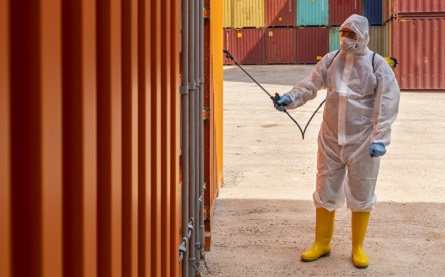A look at a new initiative, announced by the North American Plant Protection Organization (NAPPO), to help prevent the introduction of pests and diseases into the US and Canada.
 To protect North American agriculture, forestry and natural resources against the introduction of invasive pests and diseases, the United States Department of Agriculture (USDA) and the Canadian Food Inspection Agency (CFIA) have worked with US and Canadian border protection agencies, shippers, and global shipping companies to develop the following guidance for cleaning and inspecting sea containers. The guidance complements the International Maritime Organization’s Code of Practice for Packing Cargo Transport Units (CTU Code). Everyone involved in moving containers has an opportunity to protect US crops, forests, and livestock by ensuring that containers and their cargo are free from unwanted plants, plant products, insects, snails, soil, animals and animal droppings.
To protect North American agriculture, forestry and natural resources against the introduction of invasive pests and diseases, the United States Department of Agriculture (USDA) and the Canadian Food Inspection Agency (CFIA) have worked with US and Canadian border protection agencies, shippers, and global shipping companies to develop the following guidance for cleaning and inspecting sea containers. The guidance complements the International Maritime Organization’s Code of Practice for Packing Cargo Transport Units (CTU Code). Everyone involved in moving containers has an opportunity to protect US crops, forests, and livestock by ensuring that containers and their cargo are free from unwanted plants, plant products, insects, snails, soil, animals and animal droppings.
The impact of invasive pests on trade
Invasive pests threaten crops, forests, and livestock. They also have a very real impact on trade. When a contaminated container is found in port, the cargo owner, importer, or shipper can expect: delayed cargo release; demurrage charges due to cargo holds; and unexpected costs associated with having the container quarantined, tarped and treated, cleaned, or re-exported back to origin at the cargo owner’s expense.
By taking reasonable steps to keep containers and their cargo clean, shippers can help prevent the spread of invasive pests through commerce and facilitate the movement of containers through North American ports. As a result, shippers may benefit from: reduced port-of-entry inspections; faster cargo release; and fewer unexpected expenses.
Recommended self-inspection practices for industry
The risk for pests to contaminate containers and cargo is greatest at the packing location. Shippers or packers acting on behalf of shippers should put measures in place to minimise pest contamination during packing. Others in the supply chain should also put measures in place to reduce the risk of pest contamination while the container is in their control. These measures should be in accordance with individual roles and responsibilities in the supply chain and should take into consideration all safety and operational constraints ...